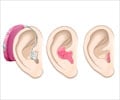Glossary
Auditory nerve: The eighth cranial nerve that transmits sounds and equilibrium or balance information from the inner ear to the brain.Bone remodeling: A natural life-long process where the bone tissue gets removed from skeleton and new bone tissue is formed in its place. Also called bone metabolism.
Cochlea: It is the auditory part of the inner ear. It is a spiral-shaped cavity that encases the sound receptor cells and a fluid that responds to the mechanical vibrations of the stapes bone.
Conductive hearing loss: When there is a problem in transmission of the sound waves through the external and middle ear into the inner ear, the resultant hearing loss is referred to as conductive hearing loss.

Ear drum: It is a thin cone-shaped membrane separating the external ear from the middle ear. It vibrates in response to sounds and thus converting sound energy into mechanical energy, to be transmitted via the three bones into the inner ear. Also known as tympanic membrane.
Hair cells: The sensory receptors of both auditory and vestibular system. The auditory hair cells are located in the cochlea of the inner ear.
Hearing threshold: The lowest sound intensity level that a person can hear in a given frequency.
Incus: The second tiny bone of the middle ear, attached to the malleus and the stapes. It is shaped like an anvil.

Malleus: Hammer-shaped tiny bone of the middle ear attached to the inner surface of ear drum at its one end and to the second bone, incus, at the other.
Ossicles: The three tiny bones located inside the middle ear; the smallest ones in human body, that help in transmission of sounds from the ear drum to the inner ear.
Otic capsule: The skeletal wall separating the middle ear and the inner ear, on which the oval and round window are located.
Otosclerosis: Abnormal growth of bone tissue on the tiny bones of the middle ear.
Oval window: An opening, covered by a membrane, found in the middle ear and leads to the inner ear. The footplate of the stapes is attached to the membrane of the oval window. Sounds are transmitted by the bone to the inner ear through this. Also known as fenestra ovalis.
Round window: One of the two openings found in the middle ear, leading to the inner ear. The membrane that covers round window vibrates with opposite phase to the vibrations that enter the inner ear via the oval window. This movement gives space for the fluid in the cochlea to move, thus stimulating the hair cells to sense the sounds. Also known as fenestra rotunda.
Sensorineural hearing loss: When there is a problem in the sensory receptors of the ear structure or at the level of the auditory nerve, the resultant hearing loss is called sensorineural hearing loss.
Stapes: The stirrup-shaped bone of the middle ear, attached to incus at one end. It is attached to the oval window at the other end.
Stapedectomy: A surgical procedure performed to remove the deformed stapes bone and replace it with a prosthetic stapes.
Vestibular system: The sensory system that contributes to balance or equilibrium and sense of spatial orientation. This information helps in movement and sense of balance.

Vertigo: Dizziness accompanied by the illusion of motion.
Pregnancy: Growth of an embryo/fetus in the uterus.
Autoimmune disease: When the immune system mistakes self tissues (self antigens) as foreign antigen (non self) and results in an inappropriate immune response it results in an autoimmune disease.
Audiologist: Health care professional who is trained to evaluate hearing loss and related disorders, including balance (vestibular) disorders and tinnitus, and to rehabilitate individuals with hearing loss and related disorders.
Anaesthesia: Loss of feeling or sensation resulting from the administration of certain drugs or gases.
Meniere's disease: A disorder of the inner ear, causing hearing loss, ringing in the ear, and the sensation that one's surroundings are spinning.












